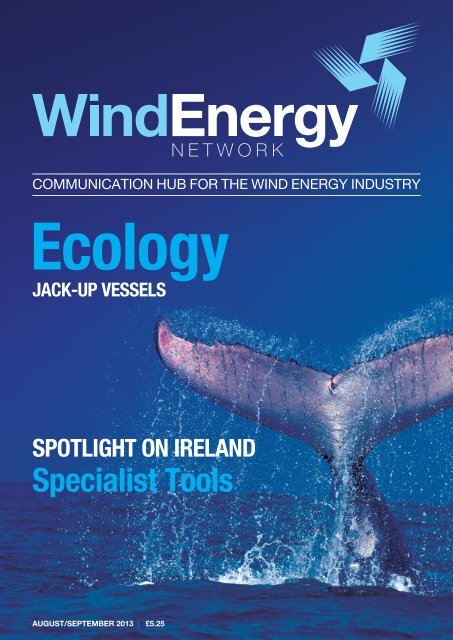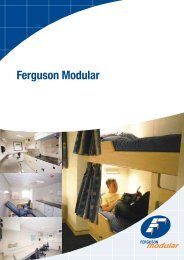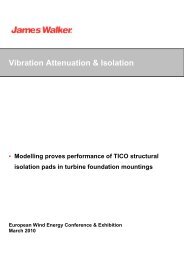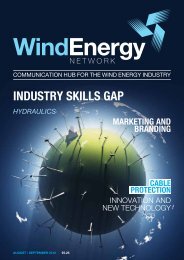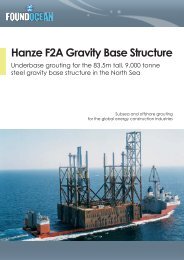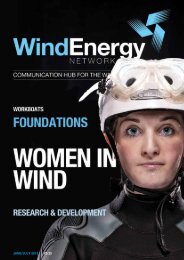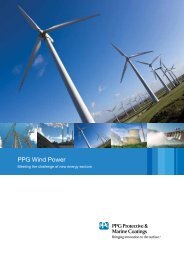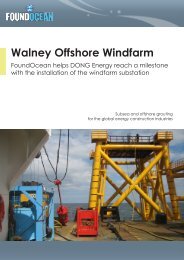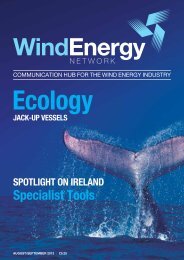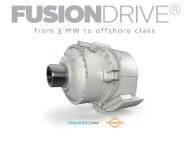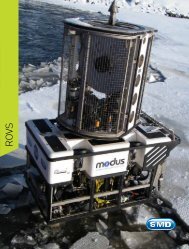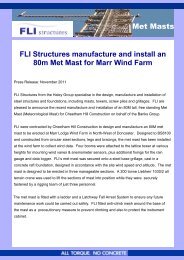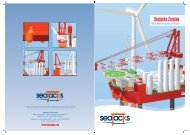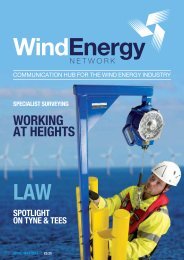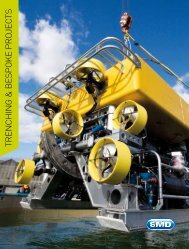what is a safety case? - Wind Energy Network
what is a safety case? - Wind Energy Network
what is a safety case? - Wind Energy Network
Create successful ePaper yourself
Turn your PDF publications into a flip-book with our unique Google optimized e-Paper software.
COMMUNICATION HUB FOR THE WIND ENERGY INDUSTRY<br />
Ecology<br />
Jack-Up Vessels<br />
Spotlight on Ireland<br />
Special<strong>is</strong>t Tools<br />
August/September 2013 | £5.25
RISK MANAGEMENT<br />
RISK MANAGEMENT<br />
Safety Cases<br />
You either love’em<br />
or hate’em!<br />
...but implement them effectively and everyone will come to love them<br />
‘Safety Cases’ well and truly divide opinion. Some see them as an <strong>is</strong>olated exerc<strong>is</strong>e<br />
of complex analys<strong>is</strong> and written work that does not reflect the real world. Others<br />
see them as a large pile of documents produced to get somebody off their back<br />
before they sit on a shelf gathering dust. Whilst regrettably there <strong>is</strong> evidence to<br />
justify these views, the more informed recogn<strong>is</strong>e that a Safety Case approach<br />
<strong>is</strong> an excellent way of ensuring projects are conceived and executed safely and<br />
ultimately provide the written demonstration that your plant, facility etc. <strong>is</strong> safe. But<br />
they are not just about the ‘now’. They provide a framework and focus for ensuring<br />
<strong>safety</strong> throughout the project life-cycle. They provide assurance that everything <strong>is</strong><br />
and will continue to be safe!<br />
But <strong>is</strong> a Safety Case approach relevant and appropriate for the wind industry For the<br />
majority of onshore wind farms in remote, rural locations, the answer <strong>is</strong> most likely to<br />
be ‘no’. The potential r<strong>is</strong>k to people, assets etc. can be readily d<strong>is</strong>counted through<br />
observation and judgment without the need for an ultimate Safety Case. For offshore<br />
wind farms the situation <strong>is</strong> quite different. Managing offshore assets, and in particular<br />
getting people on and off safely, presents a number of significant challenges and r<strong>is</strong>ks.<br />
Also, similarities with offshore oil and gas facilities presents inevitable parallels with an<br />
establ<strong>is</strong>hed Safety Case culture.<br />
R<strong>is</strong>ktec concludes its series of articles on r<strong>is</strong>k management by providing a series of tips<br />
on how to develop a Safety Case for an offshore wind farm, building on the principles,<br />
tools and techniques and proportionate approach d<strong>is</strong>cussed in previous <strong>is</strong>sues.<br />
What <strong>is</strong> a Safety Case<br />
Safety Cases are detailed documents demonstrating that facilities are<br />
designed, constructed, comm<strong>is</strong>sioned, operated and decomm<strong>is</strong>sioned in<br />
such a way as to minim<strong>is</strong>e r<strong>is</strong>ks to personnel, the public and, for HSE <strong>case</strong>s,<br />
the environment. They;<br />
• Demonstrate to management and employees, investors, contractors and,<br />
where relevant, the Regulator and/or the Public that adequate controls are in<br />
place to ensure that the major HSE r<strong>is</strong>ks ar<strong>is</strong>ing from a particular operation are<br />
both tolerable and reduced to as low as reasonably practicable [ALARP].<br />
• Provide a reference point for everyone involved with facility operations to define<br />
the requirements for effective control of Safety <strong>is</strong>sues.<br />
Imagine giving someone a document on their first day working at your facility.<br />
It describes the facility, operations and processes very clearly. It identifies the<br />
potential r<strong>is</strong>ks and provides appropriate, proportionate arguments and evidence to<br />
demonstrate that they have been reduced ALARP, referencing more detailed studies<br />
and defines <strong>what</strong> needs to be done to maintain th<strong>is</strong> position. They find it easy to read<br />
and continuously refer to it as they get up-to-speed in their new role. Th<strong>is</strong> represents<br />
a good Safety Case!<br />
1) A Safety Case <strong>is</strong> not just<br />
about the destination, it’s about<br />
the journey too!<br />
Whilst a Safety Case <strong>is</strong> the written<br />
demonstration of why a plant, facility<br />
etc. <strong>is</strong> safe, it should not be seen as a<br />
retrospective justification and certainly not<br />
a piece of creative writing to ‘get away<br />
with’ an inadequate solution. A truly safe<br />
outcome can only be achieved by fully<br />
integrating design and <strong>safety</strong> assurance<br />
activities. The documentation of th<strong>is</strong><br />
process <strong>is</strong> arguably the most important<br />
element of a Safety Case. That <strong>is</strong> why it<br />
<strong>is</strong> called a Safety Case ‘approach’; you<br />
build and develop the Safety Case as the<br />
project progresses.<br />
2) Don’t re-invent the wheel;<br />
look to other Industries<br />
Safety Cases have been around a long<br />
time in other industries; particularly<br />
Nuclear Power and Oil & Gas. A huge<br />
amount of time and effort has gone into<br />
developing these approaches. Use th<strong>is</strong><br />
to your advantage. Cherry-pick the best<br />
bits for your offshore wind farm Safety<br />
Case. Th<strong>is</strong> does not need to be limited to<br />
the overall approach and structure. Use<br />
and adapt their tools and techniques to<br />
build your <strong>case</strong>; the ‘Bow-Tie’ technique<br />
pioneered in the Oil & Gas Industry [see<br />
Dec’12/Jan’13 <strong>is</strong>sue] and the ‘Claims,<br />
Arguments & Evidence’ approach used<br />
in the Nuclear Industry [see Figure 1] are<br />
two good examples.<br />
Figure 1; Example use of ‘Claims, Arguments, Evidence’ approach to justify Integrity of Offshore <strong>Wind</strong> Turbine foundation<br />
3) Proportionality <strong>is</strong> key!<br />
The level of detail, analys<strong>is</strong> etc. you<br />
present in your Safety Case must always<br />
be proportionate to the associated r<strong>is</strong>k.<br />
Too little and your Safety Case will be<br />
inadequate. Too much and you’ll waste<br />
valuable time, effort and resources and<br />
degrade the perceived value of the<br />
exerc<strong>is</strong>e. Th<strong>is</strong> <strong>is</strong> particularly important<br />
when cherry-picking tools and techniques<br />
from higher hazard industries. As such,<br />
Safety Cases can be large and complex<br />
for say a nuclear installation [complex and<br />
highly hazardous] or be very brief and<br />
simple for less complex, less hazardous<br />
facilities such as wind farms.<br />
4) Understand the scope of your<br />
Safety Case<br />
You must be clear on <strong>what</strong> plant,<br />
operations etc. your Safety Case <strong>is</strong><br />
covering. Whilst clearly it will cover<br />
the wind turbines, it <strong>is</strong> unlikely to<br />
cover the onshore substation or<br />
access vessels as these will likely be<br />
operated by others. That said, it must<br />
dove-tail with the <strong>safety</strong> justification for<br />
these to ensure all interfaces are fully<br />
understood and mutually achieved.<br />
5) Involve all Stakeholders<br />
You must involve all stakeholders to<br />
ensure that the above interfaces are<br />
adequately managed. Involving people<br />
with hands-on experience in all aspects<br />
of the design and operation of a wind<br />
farm <strong>is</strong> critical. They know <strong>what</strong> goes on<br />
in the real world! They will bring valuable<br />
experiences from other projects which will<br />
help make your Safety Case more robust.<br />
A major benefit of a Safety Case approach<br />
<strong>is</strong> the sharing of knowledge, experience<br />
and best practice along the journey.<br />
6) Safety Case v Occupational<br />
Health and Safety Management<br />
System [OHSMS]<br />
Your Safety Case doesn’t need to<br />
go back to first principles to ensure/<br />
demonstrate your wind farm <strong>is</strong> safe.<br />
Your corporate and/or wind farm specific<br />
OHSMS should provide a framework for<br />
safe operations. Rely on your OHSMS<br />
[see Figure 2] and use it to simplify your<br />
Safety Case and ensure a cons<strong>is</strong>tent<br />
approach across all your wind farms.<br />
Figure 2; Safety Case and OHSMS<br />
Interfaces<br />
7) A ‘Life-Cycle’ Safety Case<br />
It <strong>is</strong> important that you identify key Safety<br />
Case milestones at the outset of your<br />
project. How and when are you going to<br />
demonstrate your wind farm has been<br />
designed, constructed, comm<strong>is</strong>sioned,<br />
operated and decomm<strong>is</strong>sioned safely<br />
Can these milestones be combined What<br />
structure <strong>is</strong> appropriate for each milestone<br />
8) A Safety Case <strong>is</strong> no guarantee<br />
of future <strong>safety</strong><br />
Once you have written your Safety Case<br />
don’t just stick it on a shelf and rest on<br />
your laurels. Remember, it’s action that<br />
reduces r<strong>is</strong>k, not paperwork! You must<br />
use it to retain focus on safe operations<br />
whilst making sure it <strong>is</strong> updated to<br />
reflect the evolving nature of the facility.<br />
Also, things inevitably get m<strong>is</strong>sed. Don’t<br />
become blinkered to new hazards/r<strong>is</strong>ks.<br />
Ensure emergent <strong>is</strong>sues are folded into<br />
the Safety Case as they ar<strong>is</strong>e to ensure<br />
they are managed effectively. It must be<br />
a living document that reflects the actual<br />
plant status and mode of operation<br />
otherw<strong>is</strong>e it <strong>is</strong> worthless. Th<strong>is</strong> takes effort<br />
and commitment and must be factored<br />
into your resource plans.<br />
We can’t tell you <strong>what</strong> a <strong>safety</strong> <strong>case</strong><br />
process should look like for your<br />
organ<strong>is</strong>ation because of the diversity<br />
of the industry and the internal<br />
management arrangements within<br />
your organ<strong>is</strong>ation. But if you follow the<br />
principles above you’ll end up with a<br />
valuable, proportionate process tailored<br />
to the needs of your organ<strong>is</strong>ation that<br />
doesn’t leave a bitter taste in your mouth!<br />
Gareth Ellor<br />
R<strong>is</strong>ktec Solutions Ltd<br />
www.r<strong>is</strong>ktec.co.uk<br />
38 www.windenergynetwork.co.uk<br />
www.windenergynetwork.co.uk 39


